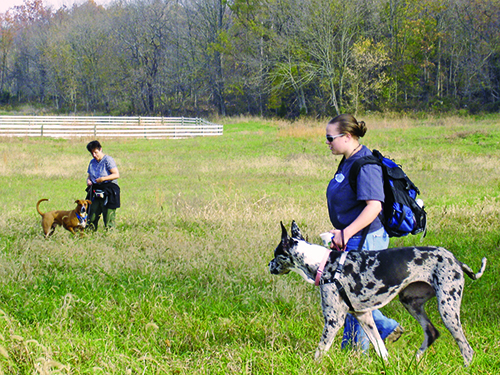Clearly, one of the best ways to help your dog have a better quality of life is to reduce the amount of stress she experiences. The first step is to make as complete a list as possible of everything that is stressful for her. This includes mild stressors as well as the significant ones. Stressors stack up like building blocks to push your dog beyond her ability to cope with her environment; eliminating even the milder ones can help keep her below that threshold. Here are five strategies for reducing stress:
1. Classical counter-conditioning. This involves changing your dog’s association with the thing she finds aversive by associating it with something wonderful (such as delicious bits of roasted chicken).
This is a slow process and you must be sure to keep the intensity of the stimulus below threshold – so the dog sees it (or hears it) and is aware of it but isn’t stressed. Your goal is to convince her that other dogs (children, men, sounds) are wonderful because they make bits of chicken appear. It is not about reinforcing a desired behavior; her calm behavior doesn’t make the chicken appear, the presence of the aversive stimulus does. (See “Fear Not,” December 2018.)
2. Operant conditioning. This involves reinforcing desirable behaviors. You can use this in a couple of different ways. If you teach your dog to adore a certain behavior (or behaviors) such as “Touch,” “Find It” (See Find It, March 2015) and “Walk Away,” (See How to Teach Your Dog to Just Walk Away, August 2018) you can use her very positive association with those behaviors to put/keep her brain in a happy place even in the presence of a stressor. As with counter-conditioning, this works best if you can start with a low-intensity stimulus.
Alternatively, you can use the Constructional Aggression Treatment (CAT) procedure to teach your dog that calm, relaxed behavior will make the bad thing (aversive stimulus) go away. As she deliberately offers calm relaxed behavior, she will become calm and relaxed about the presence of the aversive, and no longer feel the need to make it go away. This is a complex procedure, and if you choose to use it you will likely need the assistance of a qualified force-free professional.
Many cooperative-care procedures involve operant conditioning, including the Bucket Game (see “Training a Dog to Make Choices,” November 2016), a “chin rest” (see “How to Properly Examine Your Dog,” March 2014), and teaching her to file her own nails (see “Force-Free Nail Trimming Techniques for Your Dog,” August 2012).
3. Management. It’s a perfectly acceptable way to reduce your dog’s stress. Medication is one way to manage stress, and I highly recommend it for dogs who need it – sooner rather than later. If your veterinarian is not knowledgeable about the medications commonly used for behavior issues, ask her to do a phone consult with a veterinary behaviorist to determine the appropriate medication for your dog. (Most vets, well intentioned as they are, are not up to speed on the complexities of behavioral medicine.)
Another way to manage is to simply prevent your dog’s exposure to the stressor. If she’s afraid of children, don’t allow children near her. (Obviously this only works long-term if you don’t have children and don’t have frequent child visitors.) In some cases, management is a perfectly acceptable long-term solution. In other cases, it’s a mandatory short-term solution while you work to implement other stress-reduction strategies.
4. Elimination. This means getting rid of the stressor altogether. Forever. Stop yelling at your dog. Throw the shock collar in the garbage. Teach her cooperative care so there is no need/excuse for forced restraint (and seek out force-free professionals so you don’t have to fight battles about not using force). Don’t allow inappropriate interactions from any friends, visitors, or family members.
5. Live with it. We all have stress in our lives and can’t make it all go away. Some stressors in your dog’s world may not be significant enough to cause problems, aren’t worth investments of time and energy into behavior modification, and are difficult to manage or eliminate. Maybe your dog is slightly stressed if your cat occasionally swats at her nose, but they are otherwise compatible. Perhaps your dog exits the kitchen if pans clank, but otherwise seems unaffected. While keeping in mind that every stressor moves her at least slightly closer to threshold, it’s okay to decide that she may just have to live with some of the lesser ones.






Hello Pat,
We are desperate and mostly hard broken. Our family member is a beautiful 5 year old Boxer. Unfortunately, he nips and with a record of 2 grabbings minor bites to people just walking by. He is very protective of my son. We gave him away to a nice family for a day but it didn’t work out. We are very concerned, sad but have to be realistic. Do you think there’s any hope? Please, as a an animal lover can you advise. Thank you!